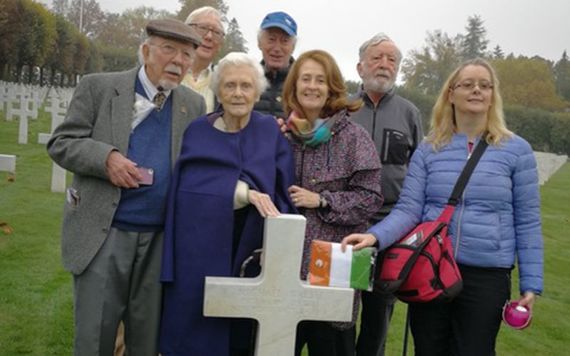Private Michael Walsh served and lost his life the American Expeditionary Forces at the Battle of the Meuse Argonne. Just last week his family finally received his Purple Heart Medal. Below his niece who helped make that happen tells his story.
From Claremorris to the Meuse Argonne: a Mayoman in the AEF 1918
On Sept 3, 1911, my great uncle Michael Walsh of Claremorris County Mayo arrived at Ellis Island, emigrating from rural Ireland, aged just 22 and like so many of his generation, in search of the American dream and a better life in New York.
Attracted by the hustle and bustle of midtown, he found lodgings in a four-story tenement house, facing into the shadow of the 2nd Ave EL, boarding with the Irish-born Drennans. Their slight, fair-haired niece, Jennie Holloway, had arrived from Offaly two years before.
Michael worked in the newly rebuilt, Grand Central Terminal as a platform man for the American Express freight agency. It was strenuous, but regular work, he earned union rates and sent money to his parents back home in Mayo. Life was full of promise.
On Apr 6, 1917, the USA entered the war on the side of the Allied forces against the Central Powers, led by the highly professional army of the German Empire. The American Expeditionary Forces (AEF) was created to deliver the massive manpower needed to overwhelm the enemy, dug in along the many hundreds of kilometers known as the Hindenburg line between the North Sea and the Meuse river, East of France.
In June 1917, Michael Walsh was drafted in New York, along with 24 million others across the US, between the age of 18 and 31. Eventually, 2.7 million would be called up, to create the ‘citizen soldiery’, as General John Pershing named them, to reinforce the exhausted allied troops of France and Great Britain.
Read more: Nearly 1,000 Irish died serving US army in World War I
Michael was one of approx. 500,000 emigrants from 46 countries who served their new country to fight a war that was not of their making, and never part of their American dream.

Soldiers in the trenches during World War I.
Inducted into the AEF in May 1918, Michael had about three weeks of training, before being assigned to Company K of the 116th regiment, 29th division, the Blues and Greys of the Virginia national guard. CO K sergeant McDaniels recalled “Most of these recruits were from New York City…there was not a man of the lot who knew enough about military life to do right face properly”, though he would later say that the new troops “progressed much better than was really expected of them”.
On June 15, they sailed on the US transport Finland, as part of a convoy of 13 ships of 70,000 doughboys.
They landed in St Nazaire, Brittany and took the ’40 men, 8 horses’ French box car trains across France to the little villages of the Haute Marne, where they were greeted as heroes by the local inhabitants, according to the school teacher in Genevrieres who wrote in his war journal ‘these soldiers are notable for their drive, their discipline, and their sense of fun’.
Michael’s last summer consisted of long night hikes, carrying their 40kg backpacks, and training in open battlefield fighting, in how to throw grenades, how to advance in assault waves, and how to quickly don their gas masks, to protect against the pervasive and deadly clouds of gas attacks.

Royal Irish riflemen photographed before the Battle of the Somme.
Michael’s unit was being saved for the final push, known as the Battle of the Meuse Argonne, which jumped off late on Sept 25. Lasting six weeks, this battle would claim the lives of 26,000 Americans and nearly 100,000 wounded, more than any other US battle engagement anywhere, then or since. Michael’s unit was assigned to the third battalion, 58th brigade, alongside the French 18th division, with the objective of pushing the Prussian regiments back through some of the toughest terrain, the heights of the Meuse, where the enemy had all the best vantage points and would affect a vicious counterattack, prepared to fight man to man to hold their position.
Pvt Michael Walsh, inexperienced soldier, still managed to survive the nonstop fighting for a month, while around him his Co K comrades fell: their commanding officer Major Opie estimated they had been reduced to one-third their original strength by mid-October.
Earlier this year, on October 24, 2018, our family group, made up of Michael’s nieces and nephews, drives through the monumental gates of the Meuse Argonne American Cemetery, near Verdun France.

Private Patrick Walsh's family gathered around is memorial cross in France.
Nothing prepares us for the sight of over 14,000 pristine, white marble crosses, crisply standing to attention in death, as they had paraded in life. Plot H, row 11, grave 9 and here it is the final resting place of Private Michael Walsh, Co K, 116th Infantry, 29th Division, 100 years to the day he was killed in action.
This is an emotional moment for my 90-year-old mother Mai O’Mahony, and for her cousins Odran Branley, 87, from Brooklyn, Pat Walsh and his daughter Karen from Claremorris and brothers Billy and John Francis Walsh from Kiltimagh, as they visit this beautiful, tranquil, vast and lonely place, so often imagined and talked about at family gatherings over the years.
We retraced his path through Samogneux, Malbrouck hill, and across the killing field of Molleville farm, where many soldiers of the 116th regiment died. In the woods of Consenvoye and the Grand Montagne, we picked our way through the undulating German trench lines, which would, in turn, become the American reserve lines as they gained the advance. We saw machine gun nests, shell holes, and corrugated German bunkers. Then we came across a large tin bucket, just sitting there where it had lain undisturbed for 100 years, riddled with bullet holes and with the side blown out, in a strange way, a small monument to the suffering of millions and to the grief of families like the Walshes.
Michael Walsh was in the front line with Co K on the 24th October 1918, as they pushed to capture an important observation tower near the Etrayes ridge. While no details were ever provided to his family, our archive research uncovered that Michael was hit by shrapnel at some point that day and was most likely the last member of his company to die, before they were pulled back from the front on the 27th October. His Irish luck had just run out.
The odyssey to France completed, there remains one final and important commemoration event for the Walsh family descendants, this coming Friday 16th November, in Glasnevin cemetery, Dublin. Michael’s family never received details of his war experience and while his parents received a pension from the US army, they never received the medals that Michael should have been awarded.
Thanks to the charity ‘Purple Hearts Reunited’, and the WW1 centennial commission, Major Zachariah Fike traveled to Dublin last week, to present Michael Walsh’s family with the World War One-era Purple Heart Medal, awarded to wounded soldiers or to families of those killed in action. In the dignified setting of the Glasnevin Cemetery Museum, we will continue in the important tradition of remembering and honoring our family members who lost their lives in the defense of other nations.
This is an excerpt from “for Francis Ledwidge” by Norris Jephson O’Connor (New York):
“you fell and on a distant field. Shell shatter’d
soaked with blood; while in your dying, Erin
Knew naught of you, nor folded you for rest
And yet I think that you are not forgotten
For even in the Irish air there will be
Somewhat of you: in the wide beam of sunlight
The song of birds will speak of you
The blackbird chirping cheerily of spring
The lark lost in the morning; and the stream
Sparkling, or dark with pools where salmon leap
Poet and soldier could your land forget?
For you each morning shall her fields be wet.
Do you have a story or part of your family history you'd like to share with the IrishCentral community? Why not sign up to the IrishCentral contributor's network here.
Read more: Records of Irish soldiers in World War I now available online




Comments